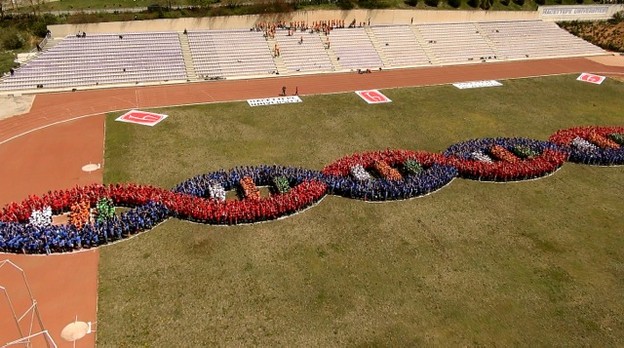The arc of our ark
Bio-poetics over the DNA rainbow

This commentary series has traced out just a few implications of bio-poetic work, and speculated on some of its futures. For all of the potential recklessness of such tampering and tinkering with genes and molecules, Steve Tomasula also imagines a “Midrash” of bio-ethics being forged, or at least illuminated, by the collective endeavors of genetic artists. Such work does much more than merely illustrate bio-tech capabilities; it performs an embodied auto-critique in which genes and bodies are put at deliberate and provocative risk. Bio-art provides us with wittily hypocritical (as well as hypercritical) risk assessments and bioethical conundrums, using the materials and the sensibility of the studio to make the “labor” in laboratory more ludic.
Barbara Maria Stafford has referred to the bio-artist as “a second Creator manipulating primal matter,” and the tension between uppercase, demiurgic Creation and lowercase (but still hubristic) manipulation indeed drives many a bio-poetic effort. Gertrude Stein’s experiments in grammar, using a non-ritual repetition to pressure units of language out of their assumed, denotative meaning, bombarded a word’s semantic nucleus and rendered it capable of new syntactic mutations. Similarly, bio-poetics play on the protean complexity of subvisible microbes and their dizzying variety of ontological admixtures. In one such work, “ewe” as sheep plays on “you” as pronoun and palindromically gestures toward our bestial past and post-species future at once.
The word “artist” might indeed, as Lewis Hyde has suggested, derive from an Indo-European particle that means “separate,” but bio-art is a matter of deep and discomfiting implication and involvement. In bio-poetic expression, language has its privileged and faux-objective status as an “immaterial” surveyor of reality upended, and words are revealed as one more vein of materials in a larger and all-including matrix.
Perhaps the animist “fallacy” of bestowing human attributes onto inert matter is less of a poetic crime now that we know that humans and nonhumans are based on recipes drawn from the same atomic components. As we reprogram genes and engineer tissues via encodings, bio-science turns toward bio-semiotics, a branch of informatics, and so the elementary, chemical language of Life itself evolves its own poetics of expression. If the tradition of the Western novel deals largely in the complexities of social classification, a particular vein of eco-animistic poetics views humanity as a class-flouting superorganism, overlapping with its fellow species in subversive ways.
Certain genes have been a part of “us” (present-day hominids) since our pre-primate origins, and a creative alertness to and exploitation of such continuum has revealed us as already-transgenic beings capable of receiving baboon hearts and cattle serums and Parkinson’s-preventing pig neurons. Where once the creation of new, compound creatures was the province of mythology, we are entering an age capable of the molecular creation of hybrids. As if to offset the species loss incurred by human pollution and incursion, we are at the advent of a prodigal and effusive engineered-species Creation. We are now domesticating molecules as we do animals and plants, because DNA is a software evermore protean and malleable.
In her bio-semiotic article “The Book of Desire,” Andreas Weber proposes a “hermeneutic” model of embryonic development, modeled on systems theory, in which a growing fetus receives genetic cues as “perturbations” to be interpreted rather than imperatives or dictations to be obeyed. To “domesticate” literally means to bring inside of one’s domicile, but transgenic domestication is a less cozy proposition, a set of guided mutations flouting certain taboos of breeding in an ambience of species vertigo.
In T. S. Eliot’s wasteland, April is cruel because it yanks slumbering chemicals out of a nirvanic, purgatorial winter’s slumber to form its lilacs, just as bio-poetics pulls inert substance into crossbred, frequently grotesque life. Such art looks into the frazzled lines between the un-, semi-, counter-, and anti-natural and pokes nagging holes into our ideas of the holistic.
Instead of emulating the human voice or transcribing mental processes onto the page, bio-poetics casts its varied lenses on the chemical meters and molecular cadences that produce our speech organs and our visual apparatus and the rest of our letter-formed bodies, going “behind” verse into the very organs of verse production and appreciation. Chemical “letters” are graphemes that do not stand for phonemes but instead frequently code for our kinetic abilities to speak and write.
By manipulating our mortal materials, bio-poetics also opens up new vistas in rendering life something more than mortal. In “The Xenotext Experiment,” Christian Bök proposes “to encode a short verse into a sequence of DNA in order to implant it into a bacterium,” in an extremophile poem so animated (as a resident inside of a self-dividing cell) that it can potentially live forever, with its coded language spiraling forward intact on a loop of organic replication.
A p.s. to Genesis: notes on transgenic/bio-poetic art